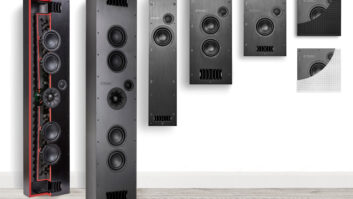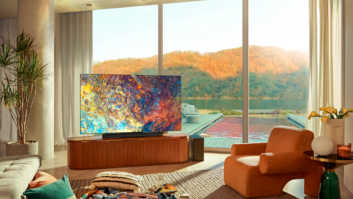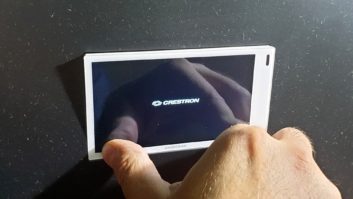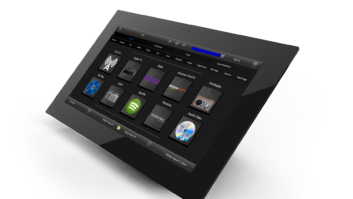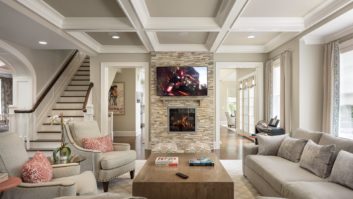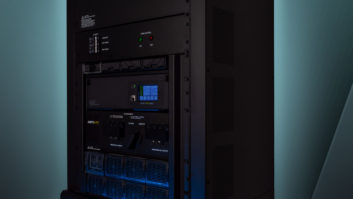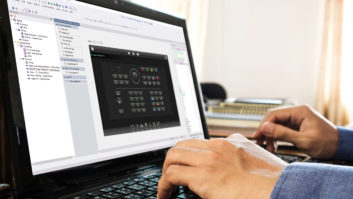Most would agree that the custom installation industry was born when the first speaker was installed inside a wall somewhere in California. Then, the custom touchpanel took over as the face of the industry–the gateway to a home’s system, where end users interfaced with their smart homes.
Then along came the iPad, and everything got weird for manufacturers of these custom touchpanels. While high-end remotes continued to offer comfort for channel surfers in integrated homes, and apps offered user-customized access when needed, manufacturers of these tailor-made touch interfaces have had to fight for relevance against outside competition, which continues to rise as interfaces like voice control further upend the status quo.
Most integrators and their manufacturer partners still make the case that the custom and semi-custom touchpanel of today is needed as a central hub to a home’s system, since they can incorporate additional elements that prefab solutions often lack.
“Touchpanels must be about more than just touch control; they need to be interactive and engaging,” said Ben Dolley, key account representative for West Coast distributor Volutone. “Adding features such as cameras, mics, and speakers to the traditional intercom revolutionized the market and made customers want to put touchpanels in their home again. With growing demand for voice control devices, touchpanels are perfect for this technology because more often than not, they are centrally located in a home.”
With advancements in touchpanel wizard- and template-based software, integrators can now install systems much more quickly, and because of the software capabilities, the panel no longer has many of the control limits it once had. “The size of the average touchpanel has increased, allowing for more creativity in system design within the home, and the resolution has also improved giving programmers the added benefit of working with high-resolution graphics,” Dolley added.

Savant’s Wally single-gang 5.5-inch touchscreen
Savant recently introduced Wally–a family of dedicated, high-resolution color touchscreens utilizing technology from Savant’s Pro Remote. Wally can control integrated climate, advanced lighting, entertainment, and activation of Savant Scenes to give users the luxury and convenience of smart home control from a small, in-wall form factor. Wally touchscreens utilize a presence sensor to activate them automatically as a person approaches, making them effortless to use.
The first Wally product is a single-gang, 5.5-inch touchscreen, powered using Power over Ethernet (PoE 802.3af).
“Our network of integrators has reported a growing demand for dedicated touchscreens in an array of sizes,” said Savant CEO Robert Madonna at the time of the product line’s release. “Our premium lineup of Wally touchscreens gives homeowners an ideal solution for any décor or application while leveraging Savant’s class-leading user interface to bring the best control experience to any room in the home.”
At CEDIA, Savant also released the next-generation TrueImage lighting software, which allows users to see, touch, control, and dim the light from any Savant control system interface directly from the photographic image, updating the color and dimness setting of the light as a visual reference on the interface screen in real time. Once a photo has been taken and stored, all user interfaces in the system update automatically, including the Savant Pro App, touchscreens, and remotes, saving valuable time for the integrator.

Crestron’s TSW-560P-W
Crestron has big touchpanel announcements planned for its Regional Summit events in Florida, Los Angeles, and New York this fall, but its continued focus promises to remain on the high end, which Crestron VP of residential John Clancy said “will always require some level of customization” that the company is known for providing.
“We will absolutely continue to focus on things like Crestron Pyng, which has a ‘fixed’ GUI, but offer end users the ability to create and customize scenes and scheduled events,” Clancy said. “Our goal is to continue the evolution in this area where most users will not need a full-custom, built-from-scratch GUI because we get it so right. However, we certainly don’t want to remove the ability for a qualified dealer/programmer to deliver to the end user something very special when wanted or needed.”
For RTI, the focus is all about simplicity and convenience for the end user. “Homeowners desire complete control over the entertainment, environment, and security but the interface must be naturally easy to use,” said RTI director of marketing Brett Stokke. “This is where the power of the RTI touchpanel interface really shines. Using our Integration Designer APEX programming software allows the interface to be completely customized to suit each client’s unique system, making it ultra-intuitive to use. Additionally, RTI offers the convenience of a touchpanel that is always on, allowing immediate control (no swiping required). Taking this a step further, many models of RTI touchpanels include proximity sensors, which wake the unit as the user approaches.”

RTI’s KX10
The key, Stokke added, is offering a control solution that is also flexible, with the ability to evolve. “When apps first came on the scene, it was widely considered to be the end of the remote control. But over time, people have come to realize that apps are not the complete solution. Voice control is also an amazing advance in the smart home, but it too has its limitations. The integrator of today needs to be able to not only use their expertise of integrating the ever-growing landscape of devices, but they must also offer their client the same level of ease across all their interfaces. RTI enables this with a wide range of solutions, from wired to wireless, app-based to voice control.”
RTI still enables completely custom control, allowing users to operate every aspect of their home simply and intuitively. The company’s control processing provides the power and capabilities to drive a home’s electronic systems, while the touchpanel drives the experience. “To achieve this, value-added features such as video intercom and direct control via RS-232 and IR provide benefits for the user, and installation options for the dealer,” Stokke said. “Another example is the KX10/CX10 touchpanels that include an HDBaseT video input, allowing the units to double as an HD display. The result is a simple, comprehensive control experience for users even when it’s driving complex systems behind the scenes.”
In addition to pointing out the advantages of incorporating video intercoms and room monitoring into his company’s TDC and TKP products, URC VP of product development Lars C. Granoe offered other use cases for custom touchpanels, especially in rooms in homes where having a remote is not viable option. For instance, “the bathroom is not a great place for a remote and a charger base,” he said. “Everyone loves music in the shower and having a remote sitting on a bathroom counter taking up space is typically not an option. Same goes for dining rooms. Ever see a remote on the dining room table or hutch?”

URC’s TKP-7600
And, of course, lighting control can provide a great use case for a touchpanel. “It is common to have the keypad at the entrance of a room near the light switch for the room,” Granoe said. “Some rooms, especially kitchens, will have multiple light switches. With a URC Total Control system controlling a lighting system, a user can simply touch a single button to create a desired lighting scene instead of turning on six or seven dimmers.”
While mobile apps are absolutely a complement to tabletop touchpanels, the time-saving ability to perform multiple functions simultaneously is the appeal of a home control/automation system, Volutone’s Dolley pointed out. “Sometimes a customer must fumble with their phone to turn down the music or pause a show because they were using another app, so it can complicate the process,” he said. “Having a stationary touchpanel that is constant and always accessible is a key feature of a control system. The app should be a bonus rather than the primary focus of a system.”
But what about when a client thinks they don’t need to invest in a touchscreen? Start by explaining the variables that can disrupt a user’s experience by relying solely on an app. “For example, if the smartphone is in use with another app, the iPad isn’t charged, you are on the phone, or you become locked out of the device, the app is no longer a convenient way to operate your system,” Dolley said.

